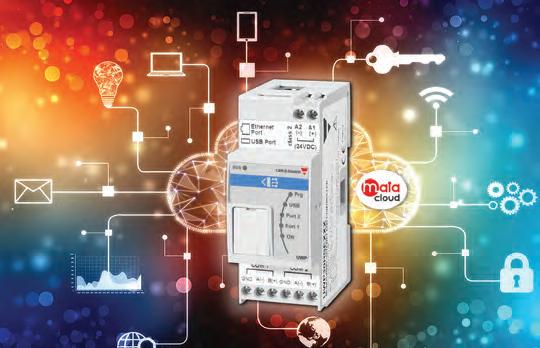TALKING HEADS Jamie Cameron
Are there really any ‘smart’ buildings? Everything is labelled as ‘smart’ these days. But what has got to happen for buildings to truly live up to that title?, asks Jamie Cameron
I
n the sphere of technology, ‘smart’ is a term which has been heavily diluted. Smart watches, smart phones, smart lighting: the list goes on. Almost every new gadget and gizmo is labelled smart without any real thought into why it is or isn’t. While on a very different scale, the UK smart building industry is suffering the same fate. There are many buildings in the UK that have been labelled ‘smart’. The truth is, there are no genuinely smart buildings in the UK. That’s not to say there aren’t any buildings making use of intelligent technologies – but flashy tech is not the beginning and end of smart, and most buildings are not doing enough to justify the ‘smart’ tag. Owing to the widespread benefits of being connected smart buildings in London command a 5 per cent digital premium. This enables building developers to increase revenue on their spaces. But in such a ‘smart’ world, this is laced with irony. In reality, in the UK, most buildings haven’t even scratched the surface of ‘smart’. In fact, it’s possible that there aren’t any legitimately smart buildings in the UK. What’s also important to recognise is that people have been working from the comfort of their own home, able to control their own environment, for a year now. Expectations have shifted and building decision-makers have a fight on their hands to convince occupants to return to their buildings and office spaces. Of course, there are buildings with intelligent technologies fitted into them, but the reality is that they’re not being used effectively enough to create a genuinely smart building – one that thinks, responds, and adapts to its occupants’ needs. This disconnect is the result of implementing smart technologies as point solutions. The sum of all these individual parts does not constitute a smart building. To create a truly smart building, which can command even more than a 5 per cent digital premium, we need to redefine what we mean by ‘smart’.
Cameron: 'we have to get deep below the surface level of smart technologies and unlock the insights they create'
‘The truth is, there are no genuinely smart buildings in the UK’ We know that smart buildings bring benefits. Indeed, two-thirds of business leaders recognise that poor connectivity is detrimental to both work-life balance and mental health, and 81 per cent of companies believe that a well-connected office leads to a betterperforming business. But ‘well-performing’ is starting to mean something new, with Environmental, Social and Governance (ESG) concerns now inherently linked to corporate success. To this end, companies are being tasked with the seemingly impossible objective of becoming carbon net-zero. That’s where smart buildings – truly smart ones, that is – come in. Technologies that we see as smart, like facial recognition on entry, automatic lighting, and app-based temperature control are often seen as ‘enough’ – they wow visitors and do improve employee experience. But none of these technologies, smart as they are, are worth the investment if they don’t actually improve how a building is run, or its impact on people, places and the planet.
Challenge goes beyond turning lights on and off The real challenge goes far beyond opening doors and turning lights on and off. It’s about tapping into the building to ensure
Jamie Cameron is director of digital solutions at Johnson Controls UK & Ireland
everyone in it can be productive, healthy, and happy, while leveraging every piece of data the building holds to save costs, bring energy usage down, and help achieve ESG goals. That is the moment when a building becomes smart. Right now, the data from each of these point solutions is siloed and disconnected. This is preventing building managers, developers and owners from seeing the bigger picture, limiting them to small, incremental changes that don’t help realise the full potential of their investment in smart. What’s more, many buildings house multiple tenants, with various needs that are subject to flux at any time. This will become truer than ever as businesses return to offices on a more flexible basis this year. For some tenants, regular heating will be less essential. Others may require less space or see cleaning requirements become more intensive. That said, some things will remain consistent: the need to drive down energy usage, move towards carbon net-zero, and provide an impressive and comfortable experience for occupants. All of this is harder to achieve when a building’s data is sitting in silos, underutilised and unable to provide a 360o view of what a building can really offer. To reach this potential, we have to get deep below the surface level of smart technologies to unlock the insights they generate. This happens when we connect smart technology systems together to create an ecosystem/platform for smart solutions, looking at the bigger picture. The data and insights this creates can then be analysed to make vast improvements across a building, and even the whole enterprise. To make this a reality, the data needs to be connected and easily accessible in the cloud. Then decision makers can analyse the data in its entirety and identify areas of improvement. These changes may sound expensive, but they needn’t be. Many buildings already have the technology in place to transform into a genuinely smart building. A 5 per cent digital premium is the tip of the iceberg in terms of benefits. So far, that’s been achieved with buildings that are faux-smart. Imagine what can be achieved – and who can reap the rewards – with buildings which are genuinely smart. Only then will we really be seeing just how smart the UK can be.
34 | ENERGY IN BUILDINGS & INDUSTRY | MAY 2021
EIBI_0521_034(XX).indd 1
10/05/2021 14:15






